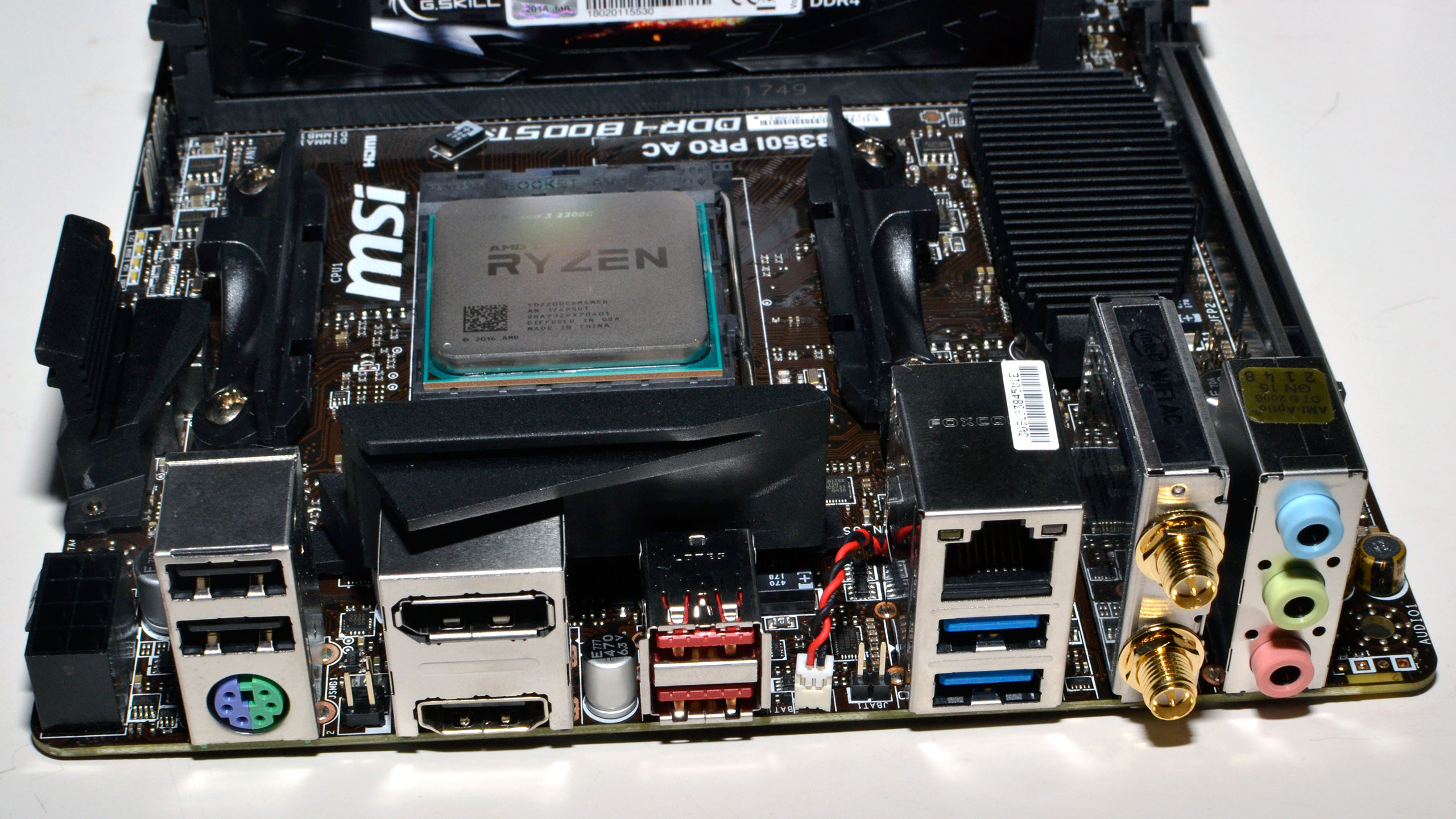Our Verdict
The Ryzen 3 2200G is the new darling of anyone looking to build a modest gaming PC or HTPC on a tight budget. It can do everything you need, provided your demands aren't too high.
For
- Great price for a modest CPU and GPU combo
- A low-power HTPC foundation
- Capable of modest (GPU) overclocking
Against
- Still struggles in more demanding games
- Built-in GPU needs good RAM for best results
- Not a great option for CPU intensive tasks
PC Gamer's got your back
Sometimes the best products aren't the most cutting-edge parts, or even the fastest parts. The best computer processor for example is the one that fits your needs, at a price you can afford. AMD has frequently been the darling of budget PC builders, and while it often requires sacrificing some performance, for the price it's tough to complain. Last year's Ryzen 3 1200 and 1300X were reasonably priced, and ultimately forced Intel to come out with the Core i3-8100—a major upgrade in CPU performance relative to the previous generation i3-7100. The one potential drawback with the Ryzen 3 CPUs was that they required a dedicated graphics card. AMD finally addresses that shortcoming with its Ryzen 3 2200G APU, and it even comes in at a slightly lower price than the outgoing parts.
AMD AM4 APU Testbed
MSI B350I Pro AC
16GB G.Skill Flare X DDR4-3200 CL14
16GB G.Skill Ripjaws V DDR4-2400 CL15
Samsung 960 Evo 500GB
Enermax Steelwing
Enermax Revolution SFX 650W
AMD AM4 CPU Testbed
Gigabyte Aorus X370 Gaming 5
16GB GeIL Evo X DDR4-3200 CL16
Samsung 960 Evo 500GB
Enermax Ostrog Lite
Enermax Platimax 750W
Enermax LiqMax II 240
Intel LGA1151 Testbeds
Gigabyte Aorus Z370 Gaming 7
MSI Z270 Gaming M7
16GB G.Skill TridentZ DDR4-3200 CL14
Samsung 960 Evo 500GB
Corsair Carbide Air 740
Corsair HX750i 750W
Corsair H115i
I reviewed the Ryzen 5 2400G earlier this week, and I included results for the Ryzen 3 2200G as well. My biggest complaint with the 2400G is that it ends up being priced a bit too high to really hit the sweet spot I was hoping for. It's a bit slower on the CPU side than a Core i3-8100, and the graphics are a bit slower than a GT 1030 (give or take depending on the game). Combined with the need for higher performance DDR4 memory to reach its full potential, I don't think it's the budget APU most users will want. The Ryzen 3 2200G has no such problems, however, with a price of only $100 and performance that's more than acceptable for light gaming and other workloads.
I covered the main design aspects of the Ryzen APUs in the 2400G article, so I'm mostly going to focus on the performance and value proposition of the 2200G here. The stock specs include a 3.5 to 3.7GHz 4-core/4-thread CPU (losing the SMT functionality), 4MB of L3 cache, and integrated Vega 8 graphics—that's eight CUs, or 512 streaming processors. It ends up a bit slower than the 2400G across nearly all tests, but then it also costs about a third less. That's a great tradeoff for an extreme budget build.
As with the other Ryzen processors, the Ryzen 3 2200G comes fully unlocked, for both the CPU and GPU. I haven't had a chance to fully push the GPU yet, but initial results suggest that with faster RAM and a 20-25 percent overclock, it can basically match the stock performance of the 2400G's Vega 11 solution. On the CPU, I hit a stable 3.9GHz, which is also the same limit I hit with the 2400G—going any further would require a better cooler than the stock AMD Spire, and that's not something I'd recommend putting money into for a budget PC.
The other CPUs were tested with the hardware shown in the box on the right. Everything used DDR4-3200 CL14 memory, though I did test the 2400G with a more affordable DDR4-2400 CL15 kit to see how that impacts performance. While it doesn't change the CPU performance much, it causes about a 15-20 percent drop in gaming performance, and that should also be true of the 2200G when paired with budget RAM. You'll definitely want to spend a bit more to get faster DDR4 if possible (eg, this kit of Patriot CL16 DDR4-3200 only costs $10 more than the DDR4-2400 kit I used for testing). Of course, given current RAM prices, 16GB is almost certainly overkill—8GB is far more practical, and I'll give a sample build near the end of the article to show what can be done.
I've left the extreme Core i9 and Threadripper processors out of the charts, and the Core i7 and Ryzen 7 are also in a different league. The 2200G is a budget processor, priced to move, and it delivers the goods. Combined with a mini-ITX or micro-ATX motherboard, you can build a complete PC for about the same price as a Core i7-8700K (especially once you add in a CPU cooler). On the graphics side, I've included the GTX 1050, GTX 1050 Ti, RX 560, and Intel's HD 630—I'll see about running some additional tests on AMD's previous generation A10-7870K in the near future, but didn't have time for this initial review. It's no surprise that all the dedicated GPUs I've tested are faster, since they also cost more than the 2200G (especially at the currently inflated GPU prices).
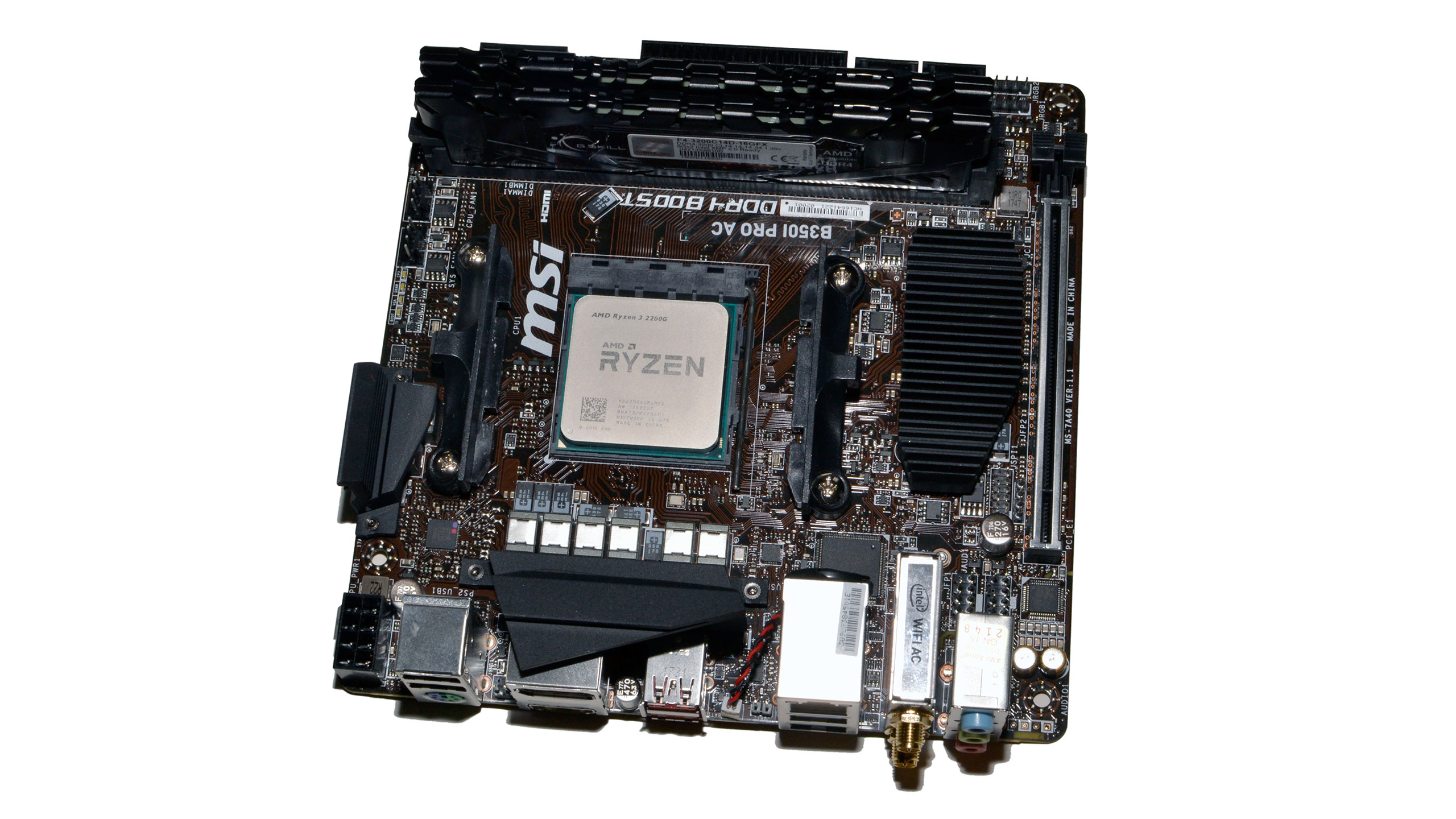
Ryzen 3 2200G gaming performance
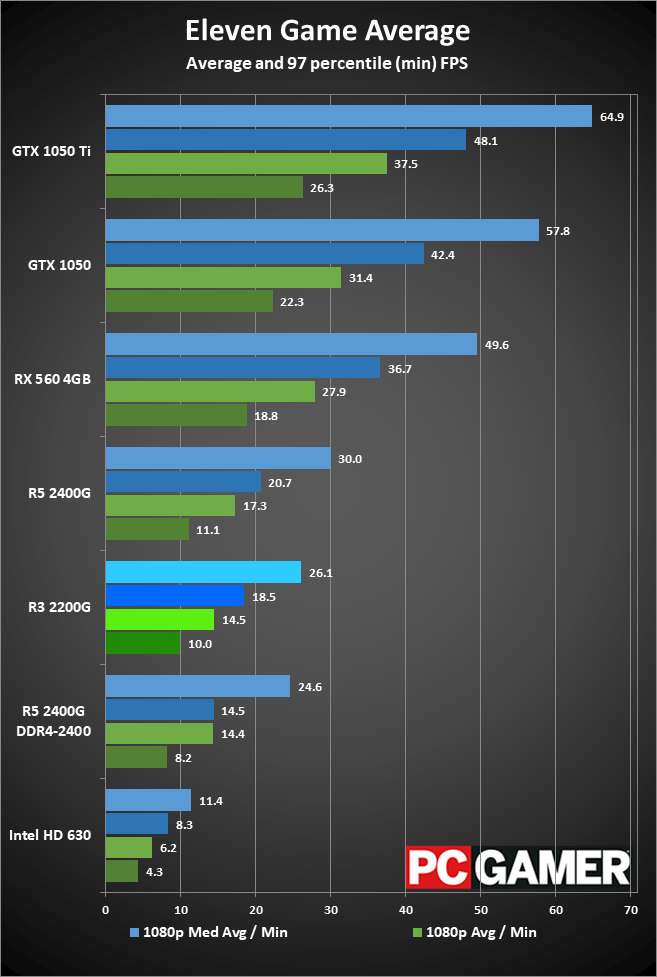
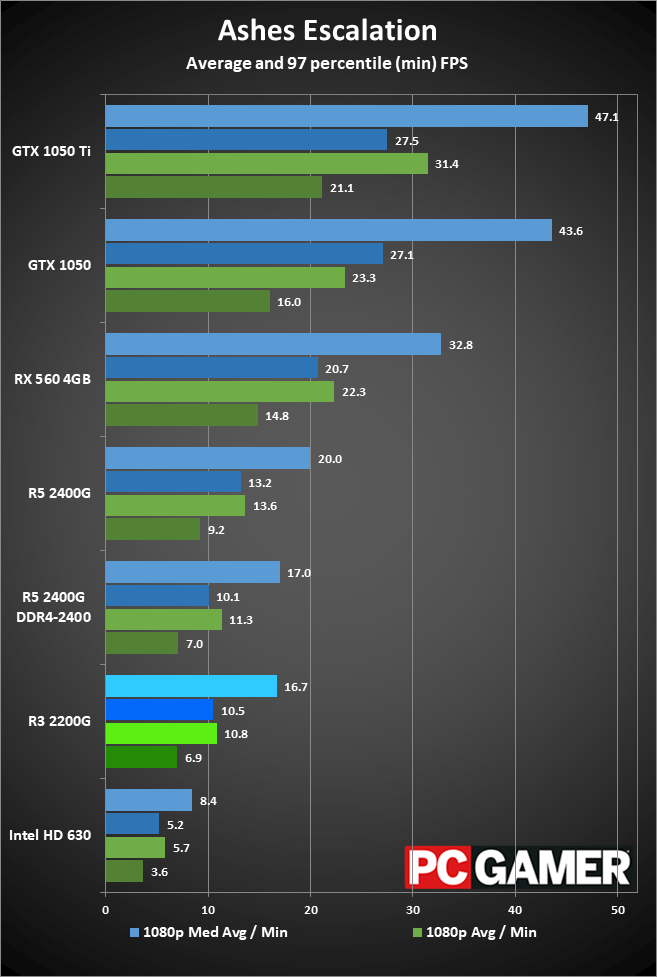
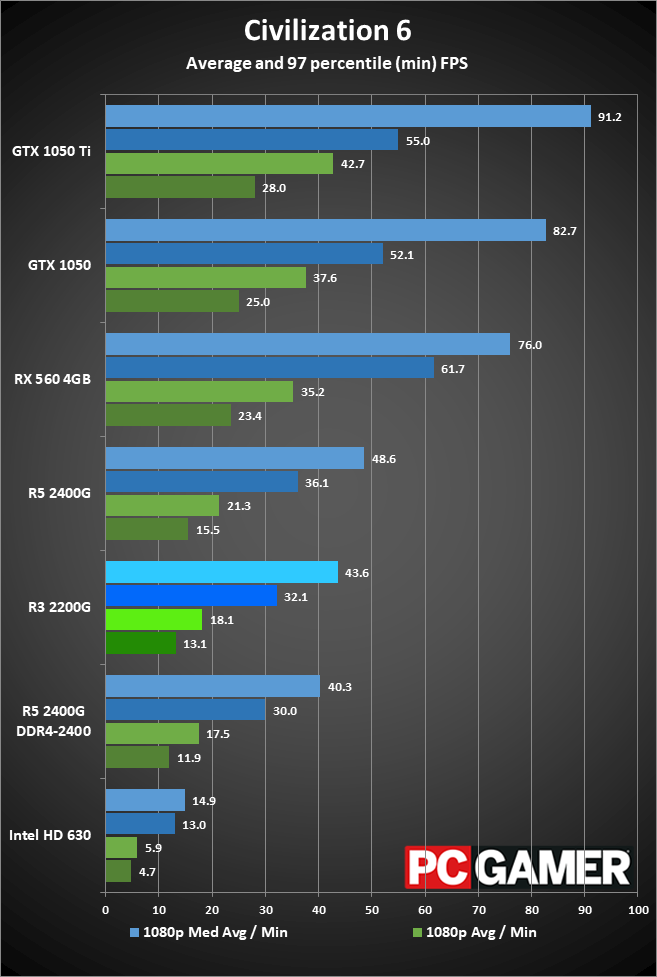

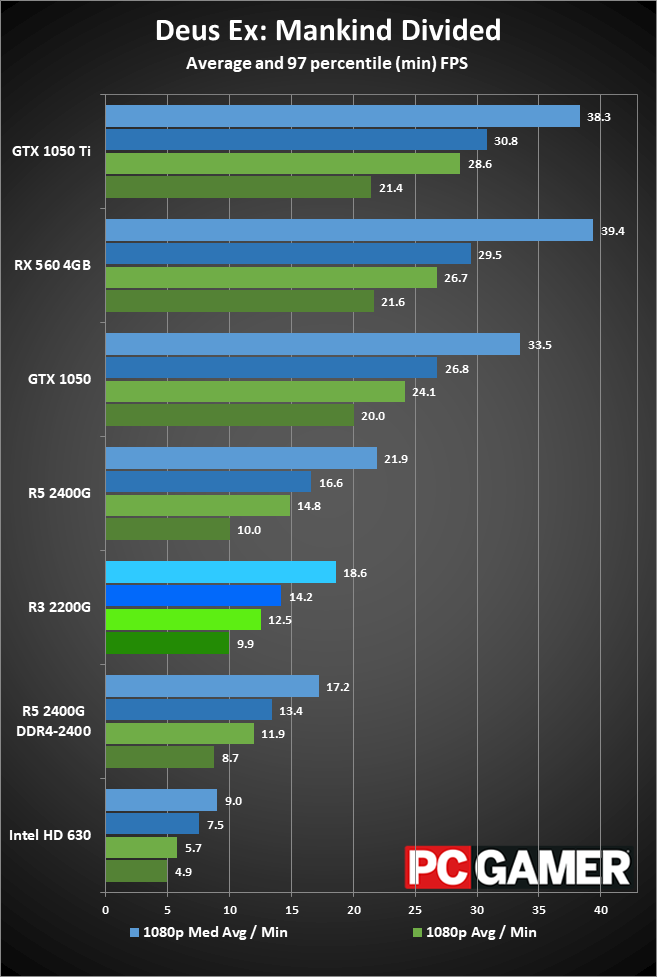
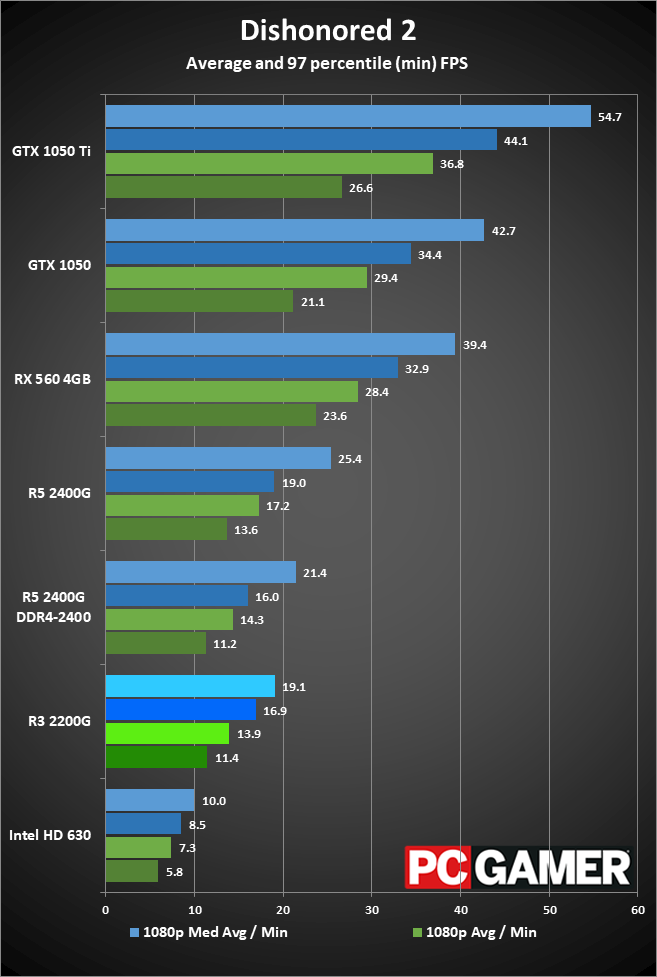
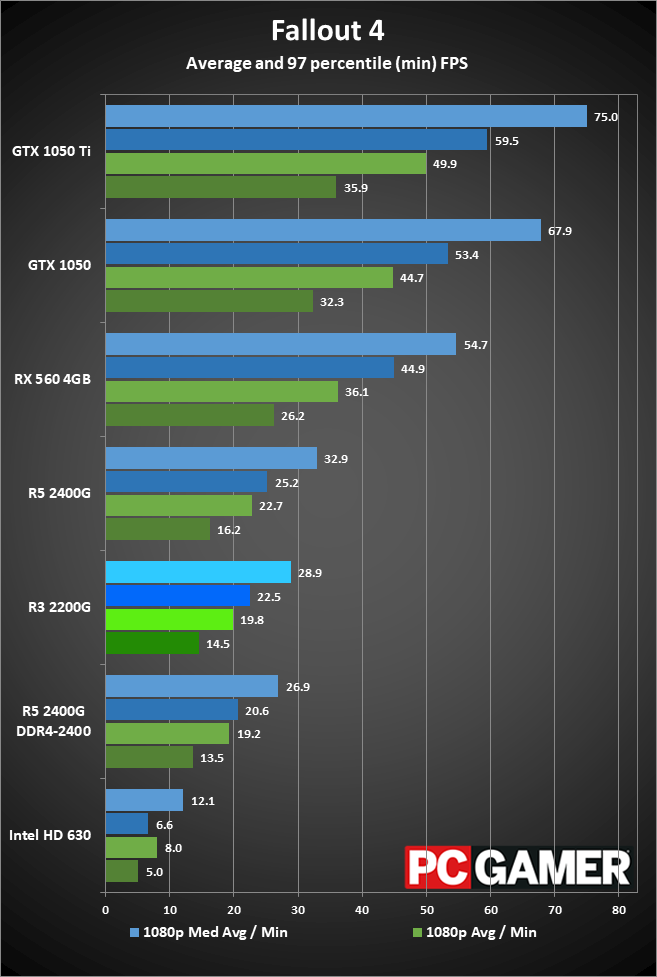
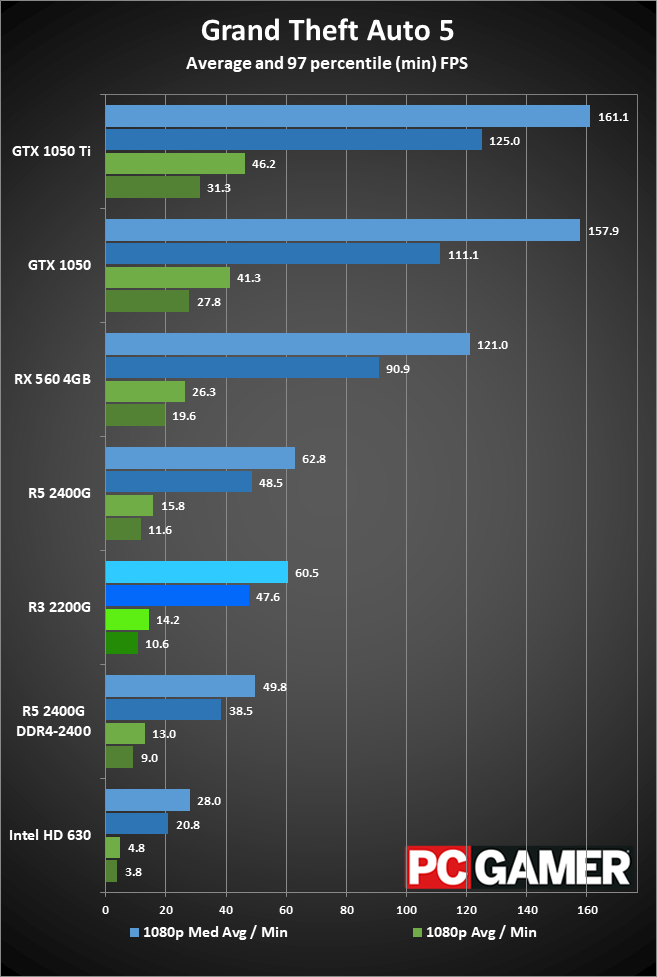
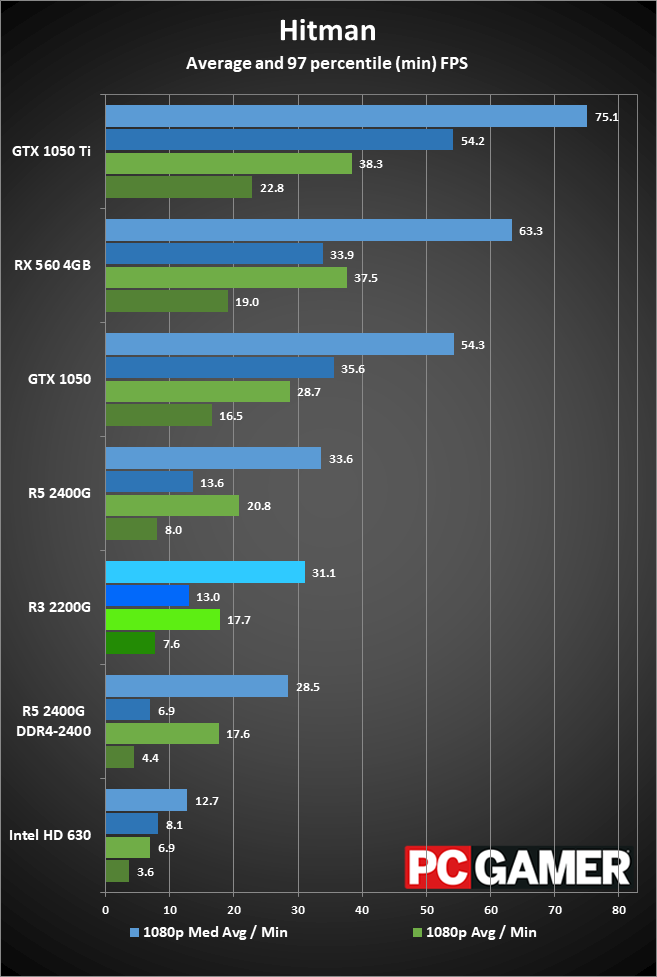
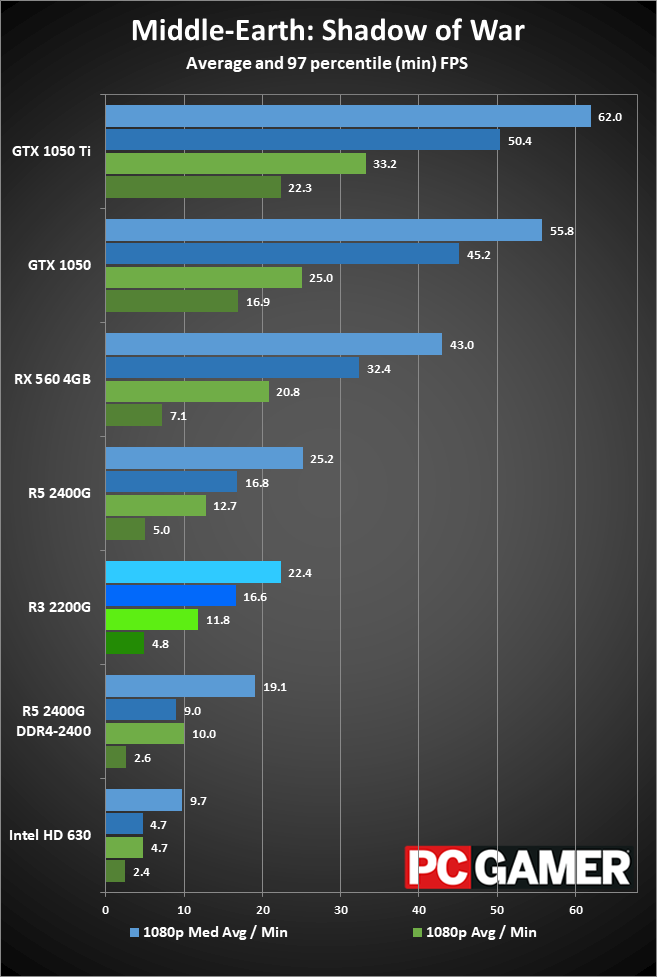
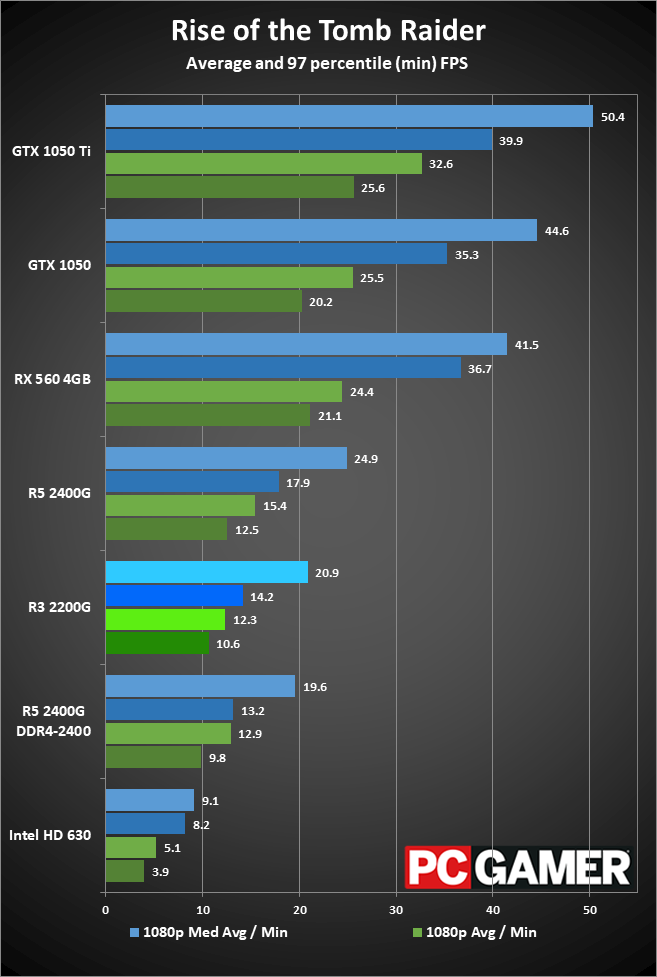
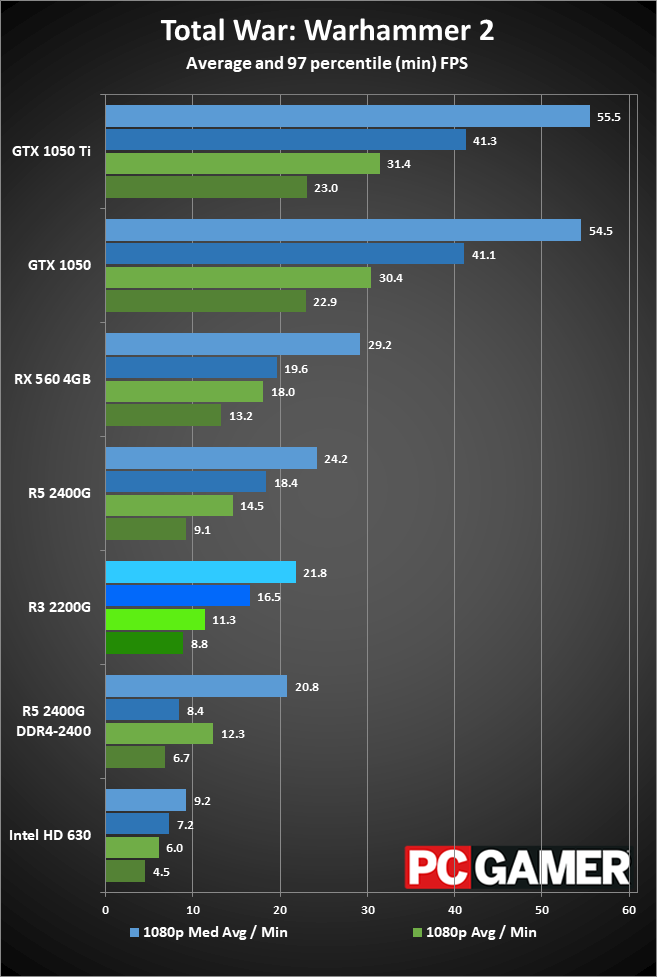
On the gaming side of things, the 2200G with high-end RAM is slightly faster than a 2400G with budget RAM. Again, definitely don't go with the cheapest RAM you can find if you're hoping to get the most of the integrated GPU. The 2200G is also more than twice as fast as Intel's latest HD Graphics 630. Neither solution is going to handle the latest games at higher quality settings and 1080p or higher resolutions, but I did some additional 1080p low testing and the 2200G gets above 30fps in the majority of games. Lighter fare is even better, so CS:GO for example easily runs at more than 60fps average (though periodic stutters and dips below 30fps are still present for some reason).
The difficulty with integrated graphics isn't something that's going to go away in the immediate future, at least not without increasing the cost. The chief problem is the need to share both power and memory bandwidth with the CPU. While it's theoretically possible to have an APU with two or three times the GPU cores as the 2200G (Ryzen 7 2700G with Vega 24, anyone?), graphics processing tends to be extremely bandwidth hungry. Dual-channel DDR4-3200 can manage about 64GB/s, a chunk of which goes to the CPU, whereas even a modest GTX 1050 has about twice that much dedicated bandwidth.
Intel's upcoming Kaby Lake-G with Vega M graphics is certainly one way of doing things, with a 4GB HBM2 stack on the package, but the cost for those chips is likely going to be over three times the price of the 2200G. Long-term, as process technology continues to shrink and we get even more transistors to work with, we'll probably on-die or on-package memory, and prices for such things will eventually come down. But until then, APUs like the 2200G will work best as entry-level gaming solutions—or as something for HTPC use, where the low power use and high integration are great to have.
Ryzen 3 2200G application performance
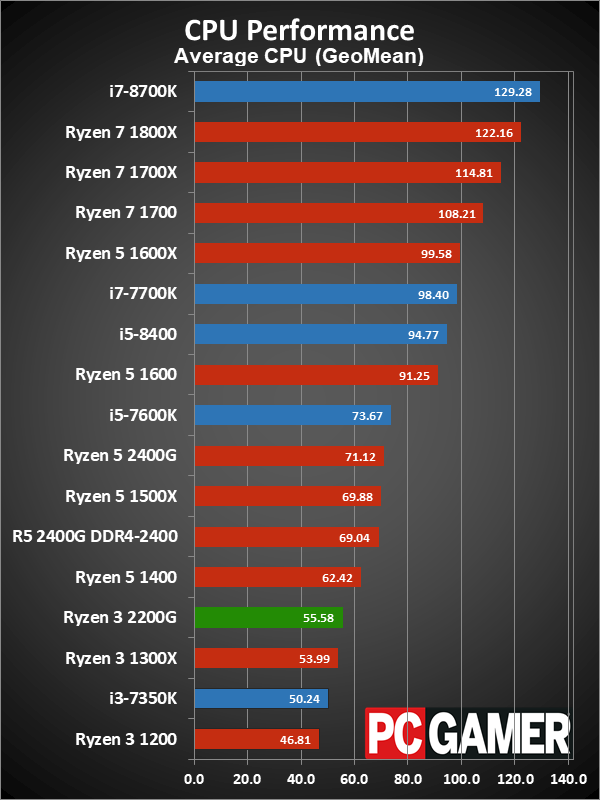
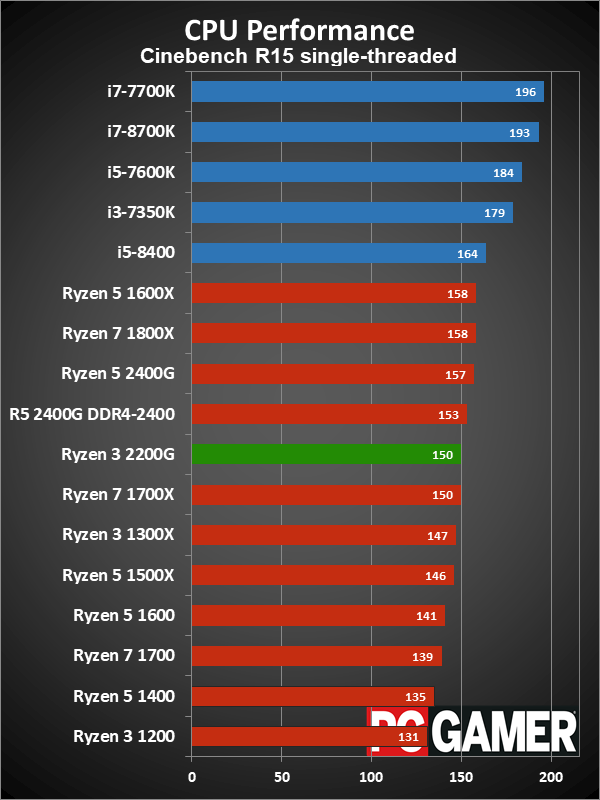
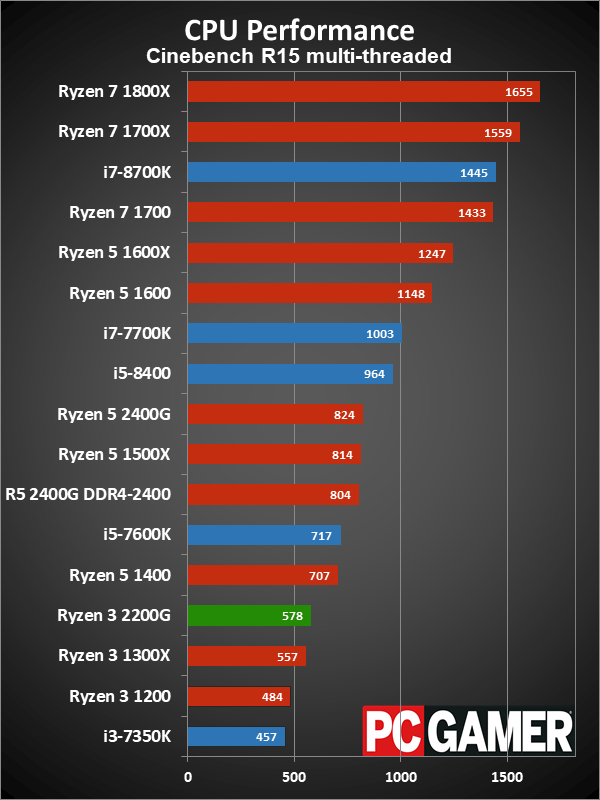
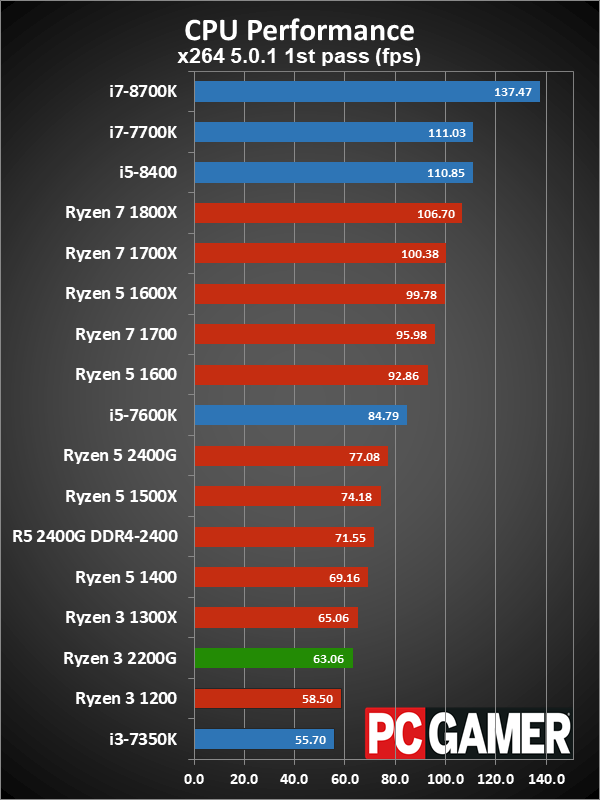
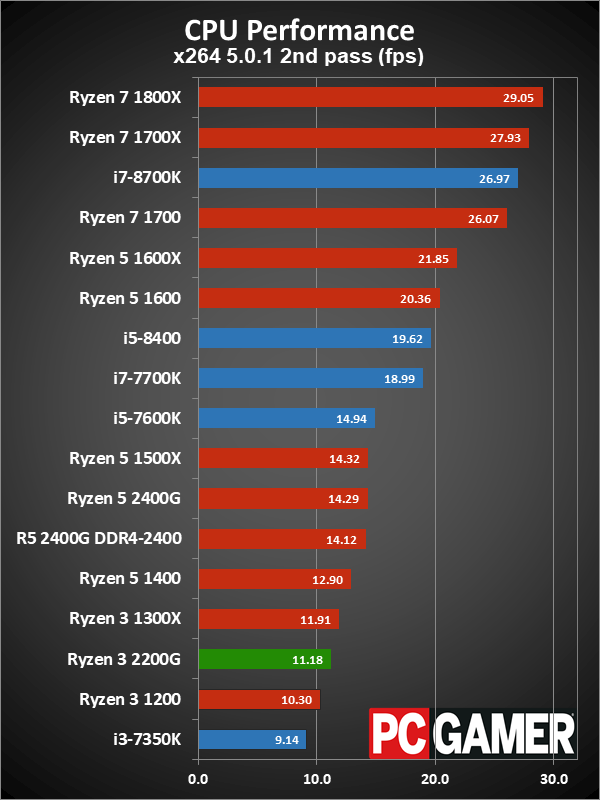
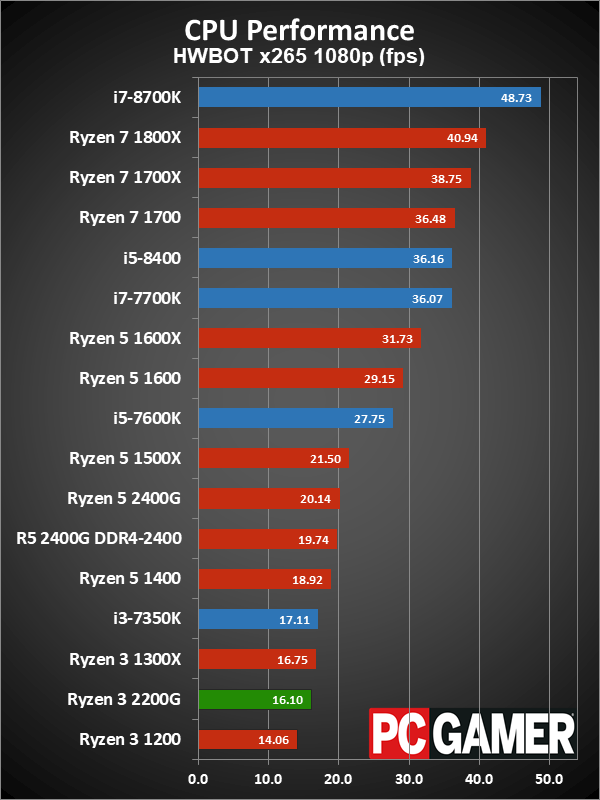
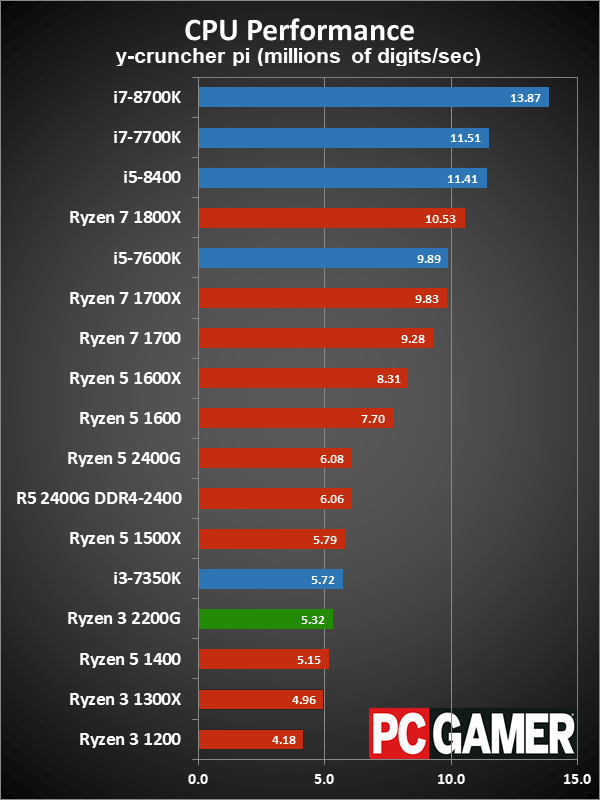
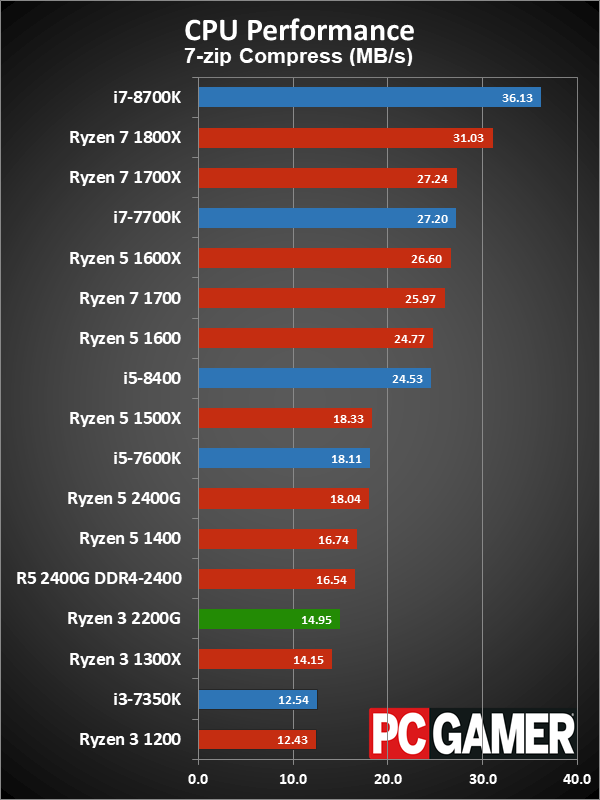
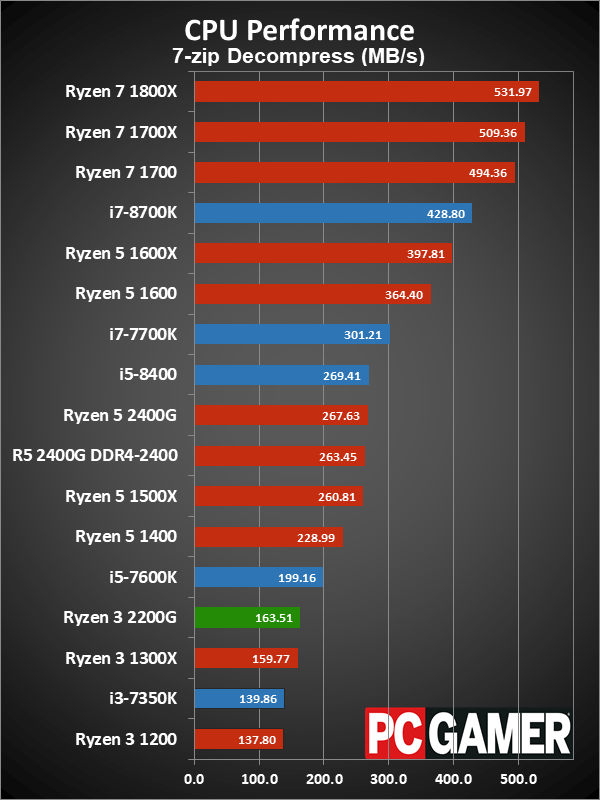
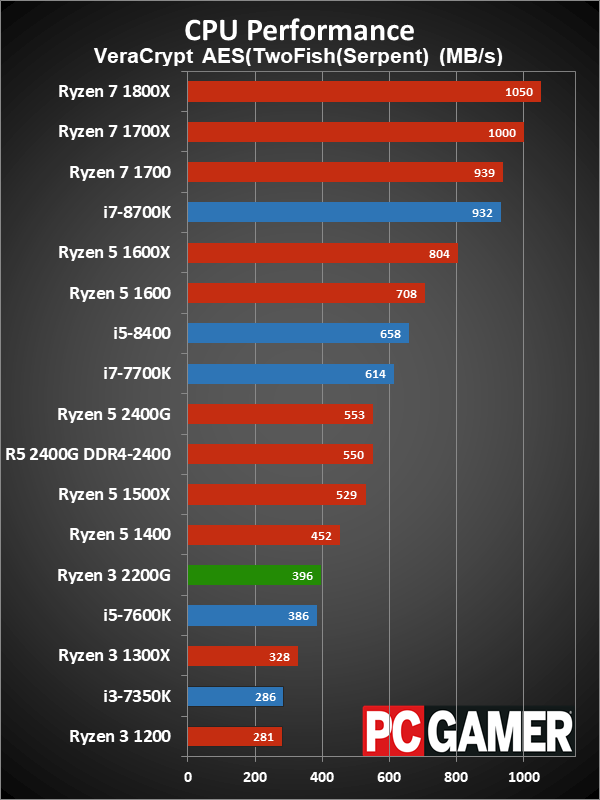
In non-gaming tasks, there's not much to say that I haven't already said. Performance is equal (and even slightly ahead of) the Ryzen 3 1300X, and a larger jump relative to the Ryzen 3 1200. If you have one of those already with a dedicated graphics card, no problem, but going forward there's very little reason to even think of the CPU-only Ryzen 3 parts. Unless prices drop below that of the 2200G, I suppose. The change from a dual-CCX (CPU Complex) layout with up to eight cores, to a native four-core solution with Vega graphics, is far more sensible in the budget market.
If you're wondering where the Intel competition sits, the previous generation i5-7600K is similar to the new i3-8100 (both are 4-core/4-thread designs), except the 7600K runs at up to 4.2GHz stock and can be overclocked. Knock off about 10-15 percent from the 7600K results in the above charts and you'd have the i3-8100. In other words, Intel's latest generation 4-core parts are a bit faster than the 2200G, but then the 2200G still has the advantage in graphics performance.
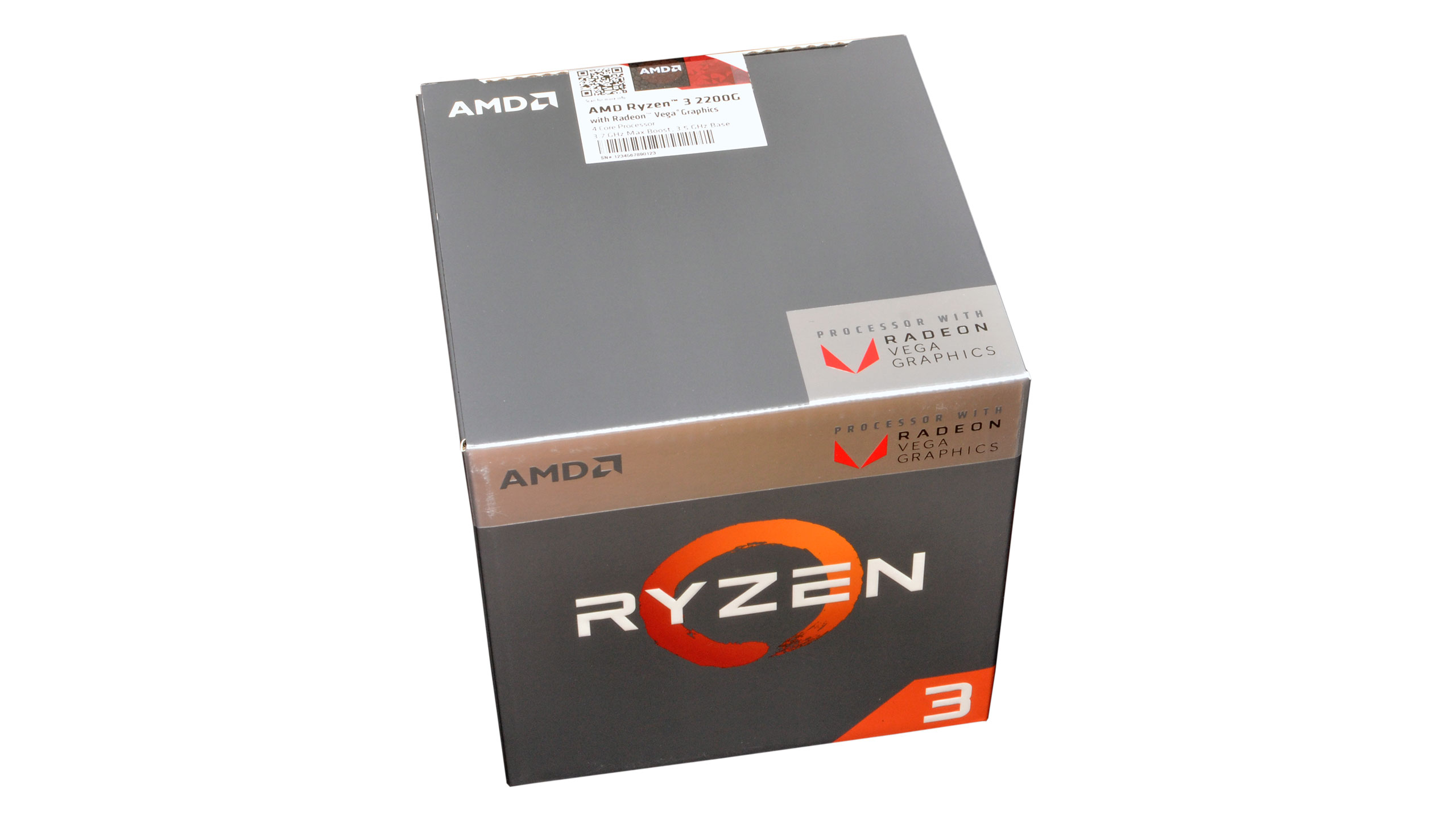
If all of this sounds great and you want to put together your very own compact Ryzen 3 2200G system, the above is one option. This build includes an M.2 NVMe SSD, 8GB DDR4-3200 memory, and a mini-ITX case and motherboard. You might be able to save a bit of money by opting for a larger case and motherboard, or a non-M.2 SSD, but I really like the idea of using the 2200G in a tiny HTPC. Of course, the 550W power supply is complete overkill, but there aren't many (any?) lower wattage PSUs that cost less and are still worth getting. You could also go with an even smaller case, if you're not interested in the potential for a dedicated graphics card or extra storage, though it's often easier to work with slightly larger builds. The total is around $400 for a complete PC with still reasonable performance—and you can add in a secondary HDD as needed.
One thing you'll want to be careful with is Ryzen APU support. Most AM4 motherboards should support the new chips, but older boards will require a BIOS update, and while some boards can be updated without a CPU (eg, using Asus's BIOS FlashBack feature and a USB drive), others will first need a Ryzen CPU and a dedicated GPU to update to the current BIOS. AMD has a support page describing the problem, and is even offering a Boot Kit as a solution if you don't have access to a Ryzen CPU. This sort of teething problem is common with new processors on existing motherboards, but it might be easier to buy a board locally if you don't want to wait for a Boot Kit.
Looking at the Ryzen 5 2400G and the Ryzen 3 2200G, while the 2400G is faster, for the target audience I think the 2200G is the being a better overall choice. If you don't want to buy a dedicated graphics card and you're just looking for an entry-level gaming PC, saving the $70 is the way to go. Once you start looking at a 2400G, it opens the doors to a lot of other potential upgrades (eg, Core i3-8100, dedicated GPUs, and more) that could quickly spiral your build from a budget system into a midrange or higher PC that costs substantially more. AMD's Ryzen APUs should also make for some potentially interesting light gaming laptops, though that's a whole different conversation.
The Ryzen 3 2200G takes everything that AMD has learned from the past seven years of building APUs and puts it to good use. The Zen architecture is a substantial upgrade over the previous Steamroller and similar CPU cores, fixing the weakest link in AMD's APU portfolio. Intel may still lead in per-core performance, but most applications don't even utilize the full potential of modern CPUs, while many games will utterly fail to run acceptably without decent graphics. If you're after a processor that's good enough, with graphics that are better than the current Intel solutions, the Ryzen 3 2200G is the solution you've been waiting for.
The Ryzen 3 2200G is the new darling of anyone looking to build a modest gaming PC or HTPC on a tight budget. It can do everything you need, provided your demands aren't too high.
Jarred's love of computers dates back to the dark ages when his dad brought home a DOS 2.3 PC and he left his C-64 behind. He eventually built his first custom PC in 1990 with a 286 12MHz, only to discover it was already woefully outdated when Wing Commander was released a few months later. He holds a BS in Computer Science from Brigham Young University and has been working as a tech journalist since 2004, writing for AnandTech, Maximum PC, and PC Gamer. From the first S3 Virge '3D decelerators' to today's GPUs, Jarred keeps up with all the latest graphics trends and is the one to ask about game performance.
